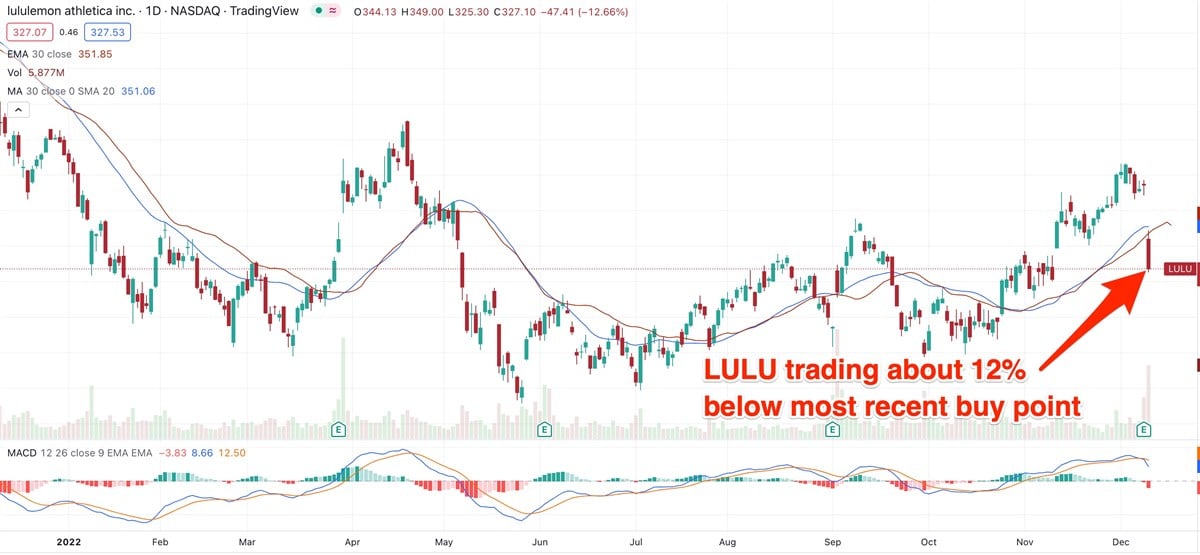Does Lululemon's 12% Drop Signal Bad News For Clothing Retailers? Luxury athletic clothing retailer Lululemon gapped down 12%, after warning of higher-than-anticipated inventories. Is this a bad sign for other clothing stocks?
By Kate Stalter
This story originally appeared on MarketBeat


Luxury athletic clothing retailer Lululemon Athletica Inc. (NASDAQ: LULU) was trading 12% lower mid-session Friday, after gapping down at the open. The move followed the company's warning of higher-than-anticipated inventory levels.
Is Lululemon a harbinger of problems ahead for clothing retailers, in an era of inflation and remaining supply-chain issues?
Other clothing retailers, such as Levi Strauss & Co. (NYSE: LEVI), American Eagle Outfitters Inc. (NYSE: AEO), Gap Inc. (NYSE: GPS) and Nike (NYSE: NKE) have said inventories were up in the past quarter, compared to a year ago.
However, as a group, apparel retailers have outperformed the vast majority of stocks, led by strong price performance of companies including Lululemon and fellow large caps Ross Stores Inc. (NASDAQ: ROST) and The TJX Companies Inc. (NYSE: TJX).
Topping Last Year's Numbers
At first glance, Lululemon's quarterly numbers look pretty good.
After the bell Thursday, the Vancouver, British Columbia-based company said third-quarter revenue came in at $1.86 billion, a 28% year-over-year increase. Earnings were $2, up 23% over the year-earlier quarter.
Those results beat both top and bottom-line views. MarketBeat earnings data show that Lululemon has a solid history of beating, or at least meeting, analysts' expectations.
But the holiday cheer was quickly soured by the company's mention of higher inventory levels. That sent shares skidding in after-hours trading and plummeting in heavy volume at the open Friday.
While same-store sales, a common retail metric, increased in the quarter, they fell below Wall Street's expectations.
Holding Above 200-Day Line
Even with Friday's price drop, which sliced through the 50-day moving average, shares remained above the longer-term 200-day line. If that holds, it's a signal that institutional investors still have conviction about the stock and aren't bailing out en masse.
Certainly, the news was mixed. The company increased its revenue and earnings guidance. It now sees sales in a range of $7.944 billion to $7.994 billion for the full year, up from an earlier forecast of a $7.865 billion to $7.940 billion range.
It expects net income between $9.87 to $9.97 per share, better than a previous forecast of $9.82 to $9.90 per share.
Even so, investors weren't ready to look at the bright side Friday. There's a case to be made that Thursday's report gave some investors a reason to take profits. Shares are up 4.01% in the past month and 8.31% in the past three months.
The stock has been trending near its 10-day moving average since rallying to a structure high of $370.46 on November 11. That represented the most recent technical buy point, but Friday's action put the stock about 12% below that point. 
Widespread Inventory Glut
The increase in inventories worried investors.
It's not a problem that's unique to Lululemon. For much of this year, retailers across various categories have reported higher inventories due to rapidly changing consumer buying habits throughout the various phases of the pandemic. Despite offering deep discounts, some items aren't moving off the shelves as fast as companies had anticipated, based on earlier buying patterns.
Supply-chain and freight delays complicated the problem. High-demand items took a long time to arrive, and once they were available, consumers were no longer interested.
For their part, Lululemon's management team maintains that ongoing demand will justify high inventory levels, rather than necessitating steep markdowns.
The company has a history of charging full price more than offering discounts. Some analysts appear to have confidence that the company can maintain its pricing power, as evidenced by MarketBeat analyst data for Lululemon, which show that four analysts boosted their price targets after the third-quarter report.
Analysts' consensus price target for Lululemon is $413.12, a potential upside of 26.30%. That's up from a price target of $400.74 a month ago.
Although clothing retailers as a group fell on Friday, one day does not make a trend. Holiday-season and fourth-quarter sales will reveal much more about changing buying habits, and the medium-term effects of inventory oversupply.










